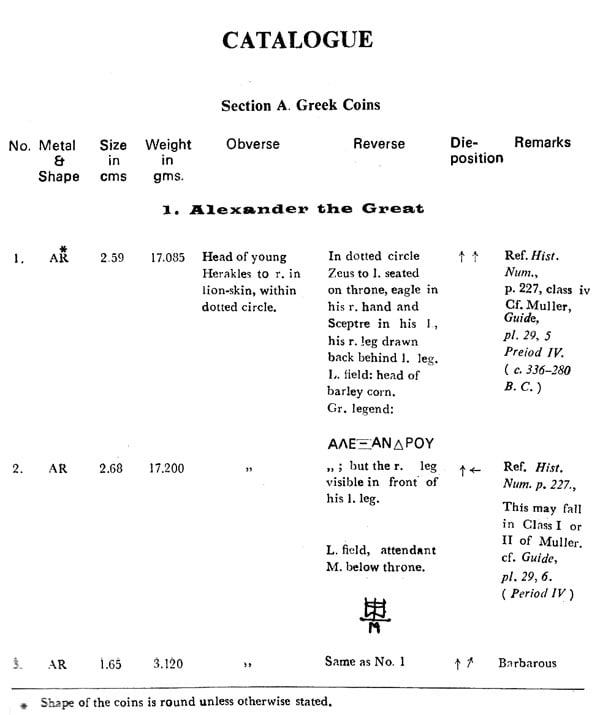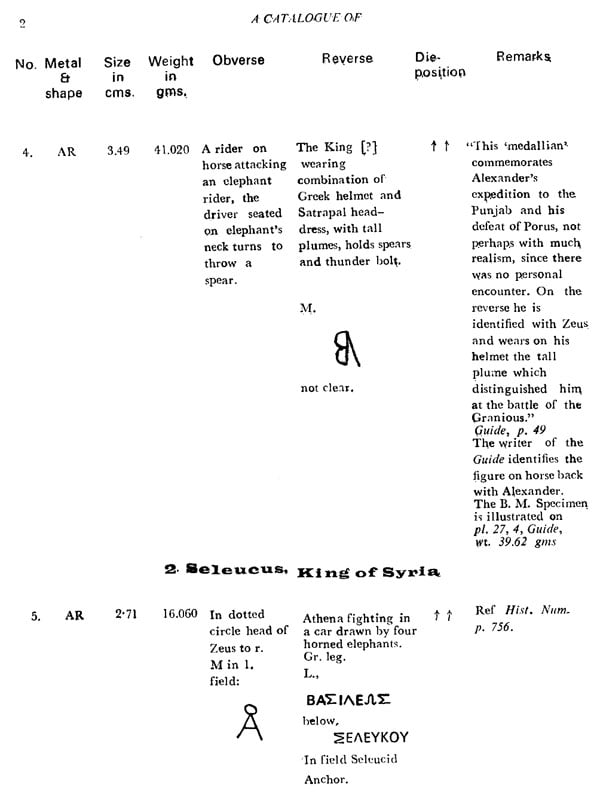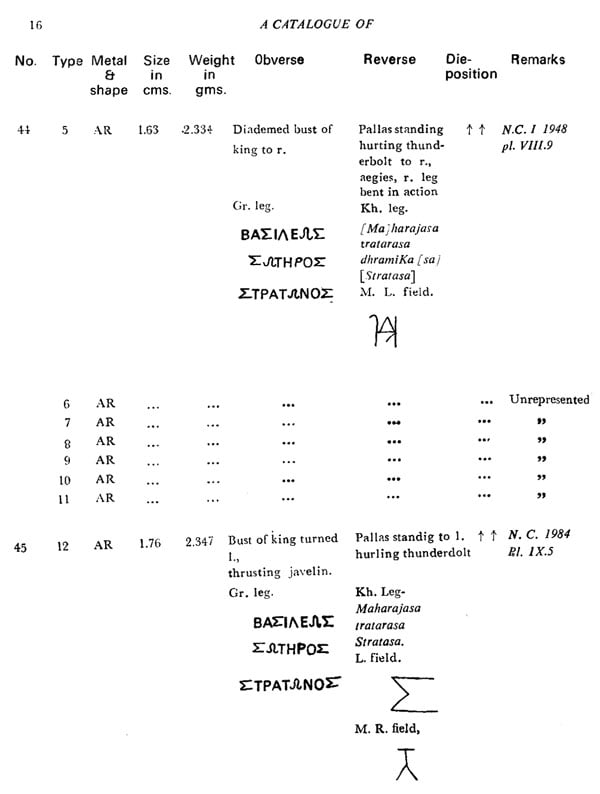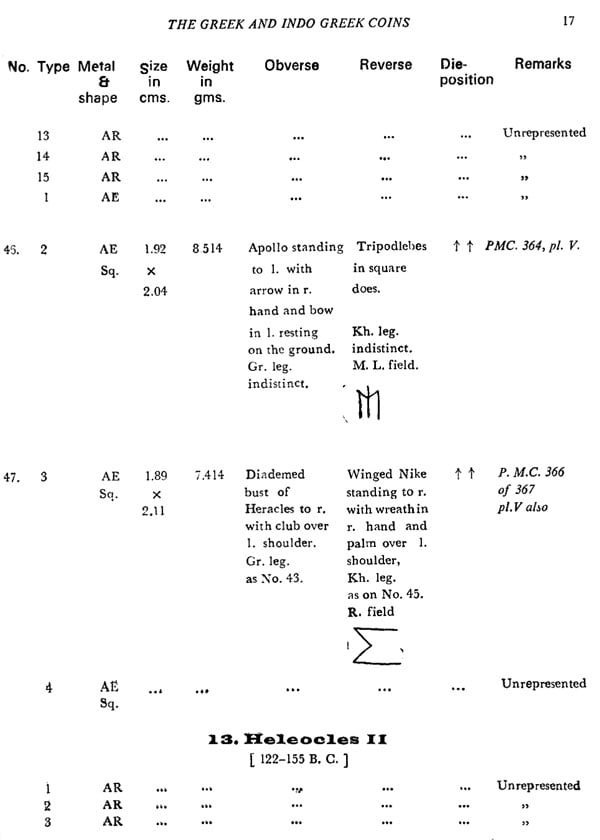
A Catalogue of The Greek and Indo-Greek Coins in the Department (An Old and Rare Book)
Book Specification
| Item Code: | NAZ826 |
| Author: | T.P. Verma |
| Publisher: | Banaras Hindu University |
| Language: | English |
| Edition: | 1983 |
| Pages: | 50 |
| Cover: | PAPERBACK |
| Other Details | 10.00 X 7.50 inch |
| Weight | 100 gm |
Book Description
Dr. R. D. Banerji, the first Nandi Professor of Ancient Indian History, Culture and Archaeology, wrote the first systematic account of Indian coins in an Indian Language. The interest of the Department in numismatic studies has persisted all these years. It had assumed the form of a formal commitment with Professor A. S. Altekar. The Department has tried to discharge this collective responsibility in many spheres of numismatic study and research. Through many sources the Department has received a sizable collection of coins. These cover many series in the history of Indian coinage. We think that these coins are to be brought to the notice of all concerned.
We have chosen to cover the Greek and lndo- Greek coins in the first instance for certain reasons. The romance of coins and their respectability as a source of Indian history and culture are very loudly pronounced by the series of Indo-Greek coins. As is well known, with the solitary exception of Menander, the memory of none of the Indo-Greek kings has survived in Indian literature. There are,no doubt, a few brief references to some of them in non-Indian sources. The epigraphic evidence also does not help us much. Without their coins the history of the Indo-Greek Kings would have been bleak and blank. From the coins we not only get their names, but can also determine the order of their succession, their mutual relationship, the extent of their political power and in some cases their religious I3anings. These coins, in their technique and finish, can compare with any other series here or elsewhere, blazed a trail of new numismatic tradition in India. They add to the romance of history. For many periods in ancient Indian history the individual is not effectively projected.
He is overwhelmed by the group to which he belongs. His individual traits are lost in conventionalised representation. We do not have reliable evidence to reconstruct individual faces and figures. For the first time in Indian history the Indo-Greek kings peep out of their coins as real human beings. They no longer remain mere abstraction or vulgar or formalised types.
We do not propose to give the special features of the coins catalogued here. The study of Indo-Greek coins and of the history based on them has received painstaking analysis from a long line of eminent scholars. We know that our own catalogue is in no way an improvement upon their researches. Here we simply record our coins Incidentally we may point out that our collection includes a scarce piece which is supposed to represent the epic encounter between Alexander and Pours. I thank my colleague Dr. T.P. Verma, Reader in the Department, for preparing the catalogue. M/s Bani Press deserve out thanks for doing a good job within a very short time.
This Catalogue is of the Greek and the Indo-Greek coins in the cabinet of the department of Ancient Indian History, Culture & Archaeology, Faculty of Arts, Banaras Hindu University. There are in all 107 coins in this section; 62 silver and 45 copper. They represent 27 kings:3 Greek and Syrian, 23 lndo-Greek, and 1 otherwise unknown, Indian satrap, Sophytes.
There are only four silver coins of Alexander the Great. Nos. 1 and 2 are attic tetradrachms of the period between 336 to 280 B. C., no. 3 is a barbarous imitation, while no. 4 is a commemorative medallion. Though there is no inscription on this medal, it is alleged to commemorate the victory of Alexander over Porus, the king of Punjab. The obverse scene shows two men riding on an elephant, the driver seated on the neck of the elephant, being turned back to throw a spear. From behind a horseman attacks the elephant riders. This horseman is sometimes identified with Alexander himself and sometimes with Ambhi, the Gandhara prince and a general of Alexander. On reverse figure is seen in the form of Zeus. Nike flies to crown him. This Nike scene of the reverse and the spear throwing on the obverse is obliterated in our specimen. This is quite clear in B. M. specimen, Guide pl. 27, 4. This is a rare coin, and no coin has been reported from India. It is very doubtful whether this can be taken to commemorate the so called victory of Alexander over Porus. Some scholars think that the scene depicted on this medallion commemorates the battle between the Bactrian king Eucratides or Heliocles. (See Num. Chron. 1887. p. 1/7) However there is no evidence to relate this coin with Alexander's victory in India. The fabric and the quality of execution is also of very inferior.
Only two Seleucid kings, Seleucus I and Antiochus I are represented in our collection. The copper coin no. 11 may be of Antiochus II.
No. 12 is a fine specimen of the silver of Sophytes. This seems to be a genuine coin. It is rare and only one type is known to us. The head of the king seems to have been imitated from a coin of Seleucus I.
**Sample Pages**











